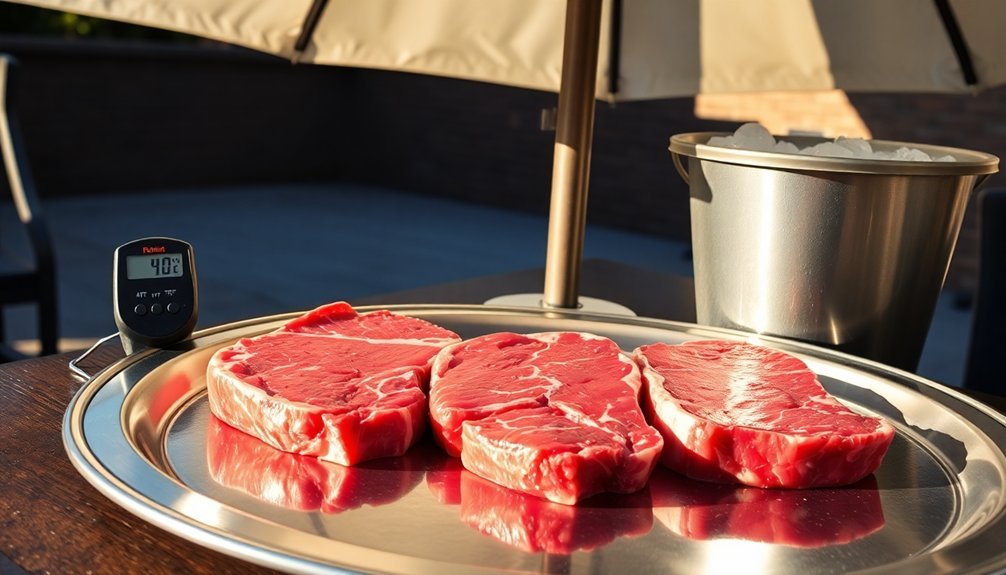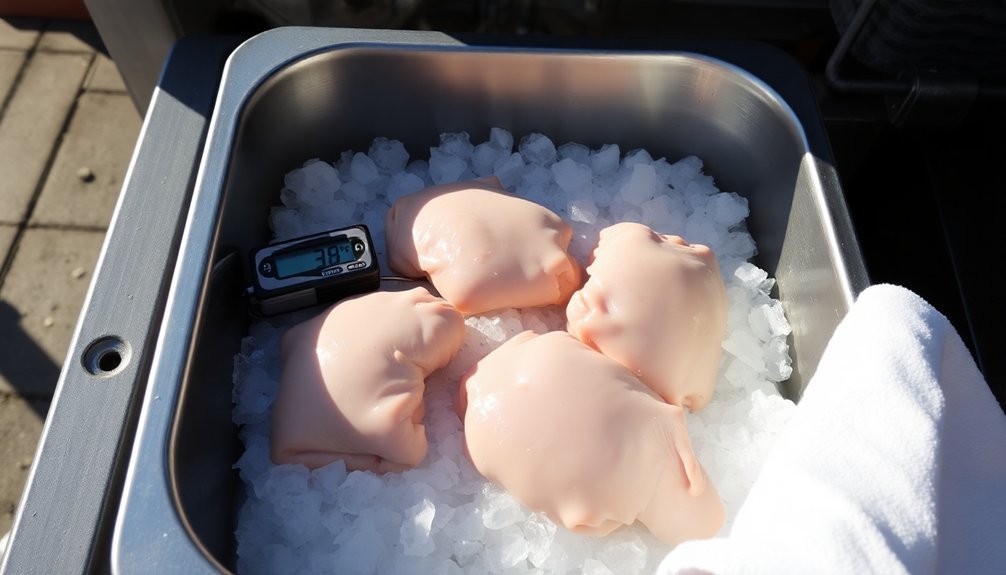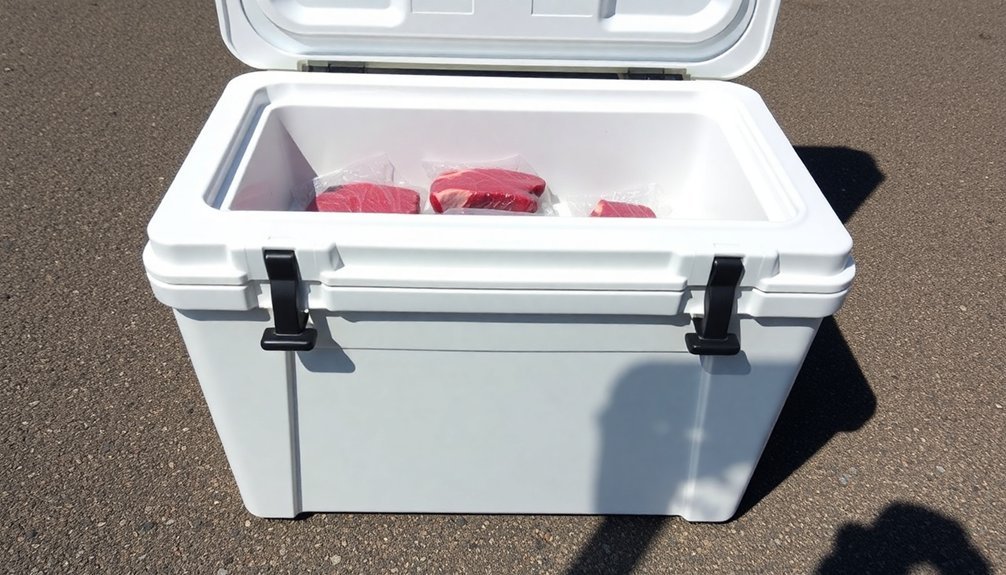Never leave raw meat in direct sunlight for more than 2 hours, and limit this to just 1 hour when temperatures exceed 90°F. You'll want to keep raw meat refrigerated at 40°F or below until you're ready to cook it, using insulated coolers with ice packs for transport. Always handle meat on clean, designated surfaces with separate cutting boards and utensils to prevent cross-contamination. Monitor internal cooking temperatures with a reliable thermometer: 165°F for poultry, 160°F for ground meats, and 145°F for whole cuts with a 3-minute rest. Understanding proper meat handling is just the beginning of ensuring your outdoor cooking success.
Timing Your Outdoor Preparation

Backyard chefs know that timing is everything when preparing raw meat outdoors. When you're planning to grill, don't let raw meat sit in the sun for more than two hours.
If it's particularly hot outside (90°F or higher), you'll need to cut that time down to just one hour.
You'll want to keep your raw meat refrigerated until you're ready to cook, as bacteria can multiply rapidly in warm conditions – doubling every 20 minutes.
Harmful bacteria like Staph, E. Coli, and Campylobacter thrive when meat is left out at unsafe temperatures.
Since you can't see, smell, or taste dangerous bacterial growth, it's essential to track your timing carefully.
Use insulated coolers with ice packs to maintain temperatures below 40°F when transporting meat to your grilling location, and don't remove the meat until you're ready to cook.
Temperature Monitoring While Cooking
While raw meat preparation requires careful attention, properly monitoring cooking temperatures is equally essential for food safety.
Proper temperature readings enhance both safety and taste by helping you avoid overcooking your meat.
You'll need a reliable thermometer to check internal temperatures: poultry needs to reach 165°F, ground meats 160°F, and whole cuts 145°F with a 3-minute rest period.
Insert your thermometer into the thickest part of the meat, avoiding bones and fat. For thin cuts, slide it through the side and slowly pull back to find the lowest temperature reading.
Digital instant-read thermometers give you quick results in about 10 seconds, while dial versions take 15-20 seconds. Once you've reached the proper temperature, let your meat rest for at least 3 minutes.
During this time, maintain hot food at 140°F or above to prevent bacterial growth.
Proper Storage Between Steps

Proper storage between preparation steps is critical for maintaining meat safety and quality. You'll need to store raw meat in sealed containers at the bottom of your fridge to prevent cross-contamination.
Make sure you're using airtight containers or plastic wrap to catch any drips and keep juices from touching other foods. When you're working with multiple types of meat, store them separately and designate specific prep areas for each.
The use of ice packs will help maintain proper temperature during any temporary storage. Don't forget to label your containers with names and dates. If you're marinating, use stainless steel or plastic pans with tight-fitting lids and extra cellophane wrap.
For longer storage periods, wrap the meat tightly and place it in the freezer at 0°F. Keep your work area clean by washing all utensils and surfaces with hot water and commercial-grade soap.
Clean Workspace Management
Maintaining a clean workspace is essential when handling raw meat to prevent foodborne illness and cross-contamination.
You'll need to designate specific areas for raw meat preparation and use separate, color-coded cutting boards and utensils to prevent cross-contact with other foods.
Before starting, clean and sanitize all surfaces thoroughly.
After handling raw meat, scrape away residue with a rubber scraper, then wash surfaces with hot soapy water.
Follow up by applying a sanitizing solution and allow surfaces to air dry.
Don't forget to wash your hands for at least 20 seconds before and after meat handling.
Make cleaning a daily habit by washing all tools and surfaces immediately after use.
Clean coolers weekly, and address any spills right away to maintain a safe food preparation environment.
Safe Transport Methods

The safe transport of raw meat requires careful attention to packaging, temperature control, and environmental protection.
You'll need to use separate containers for raw and cooked products, ensuring all packaging is leak-proof and nontoxic. Pack your meat in industry-approved shipping bags or shrouds if the original packaging isn't secure.
Transport your meat in refrigerated vehicles or insulated containers, maintaining temperatures at 4°C or below for fresh meat and -18°C for frozen products.
Don't leave meat unrefrigerated for more than two hours. Move quickly during loading and unloading to minimize exposure to contamination.
You'll want to protect the meat from direct sunlight, wind, and rain using clean, sanitized tarps. Choose appropriate travel times and avoid adverse weather conditions that could compromise product safety.
Frequently Asked Questions
Can Raw Meat Be Safely Repackaged Outdoors Before Cooking?
You shouldn't repackage raw meat outdoors due to contamination risks. If you must, work quickly on a clean surface, use fresh packaging, and wash your hands thoroughly before and after handling the meat.
Does Meat Marinated in Citrus Tolerate Sunlight Exposure Differently?
No, citrus marinades don't change how meat tolerates sunlight. You'll need to keep your marinated meat refrigerated just like any raw meat. The marinade's only there to add flavor and tenderize.
How Does Altitude Affect Raw Meat's Exposure Time in Sunlight?
You'll need to reduce sunlight exposure time considerably at higher altitudes since UV radiation increases 10-12% per 1000 meters. Your raw meat will degrade faster due to the thinner atmosphere and intensified UV rays.
Can Vacuum-Sealed Raw Meat Withstand Sunlight Longer Than Traditionally Packaged Meat?
While your vacuum-sealed meat will resist sunlight damage better than traditionally packaged meat, you shouldn't rely on this protection. It'll still degrade faster in sunlight and should be kept in dark, cool places.
Does Meat Color Change Indicate Unsafe Exposure to Sunlight?
No, you shouldn't rely on meat color changes to determine sun exposure safety. While sunlight causes myoglobin oxidation, turning meat brown or grey, these changes don't necessarily mean the meat's unsafe to eat.
In Summary
By following these best practices when handling raw meat outdoors, you'll greatly reduce the risk of foodborne illness and guarantee a safe cooking experience. Remember, you're racing against time and temperature when meat's in sunlight. Keep your thermometer handy, maintain a spotless prep area, and don't let your guard down during transport. With these habits, you can confidently tackle outdoor meat preparation.





Leave a Reply